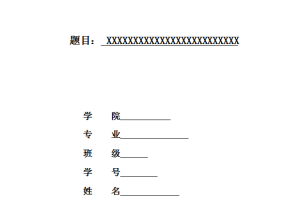摘要
我国房地产业发展的很迅速,房价目前来说是比较居高不低的。在这种特殊情况下,国家对于这种现象采取了宏观调控的措施来压制房子的价格,国家采取这种措施直接增加了房地产企业的压力。房地产企业要想在这种机制下存活就必须要加强企业的成本管控,要想在行业中获得优势取得明显的成绩,也必须严格去控制企业的成本。企业的财务管理制度、人力资源管理制度等也对企业成本控制制度起到了不同程度的影响。企业最终的目标是以低成本去实现最大的利润或效益。
本文采用了实证分析的方式,对中海地产集团有限公司的成本管理现状进行了分析,其中包括了对其现有的管理制度、管理体系等进行了较为全面的研究,分析了集团公司在我国房地产行业中所占据的位置,并简单地概括了集团公司的情况以及其成本管理的问题。最后分析并解决了中海地产成本管理中存在的问题。
关键词:全面成本管理 成本管理 中海地产
ABSTRACT
China’s real estate industry is developing rapidly, the current price is relatively high low. In such a large environment, the state has greatly strengthened the macro-control of real estate enterprises, which to some extent increased the pressure on the real estate business. If the real estate enterprise wants to win and obtain the economic benefit and the market competition ability, it must strictly control the enterprise’s cost. The traditional cost management method system, enterprise system and so on will have some influence on the cost of the enterprise. The ultimate goal of an enterprise is to achieve maximum profits or benefits at a low cost.
In this paper, taking Zhonghai Real Estate Group Co., Ltd. as an example, it introduces the background and content of the research on cost management of Zhonghai real estate. Secondly, in the real estate cost management system, cost management system are described in detail. The cost management related concepts are described, analyzed the present status of the real estate industry and real estate industry in the status of. The basic situation of Zhonghai Real Estate Company is briefly summarized, and the present situation of cost management in this enterprise is described. Finally, it analyzes and solves the problems existing in the cost management of Zhonghai real estate.
Keywords:Total cost management; Cost control;China Overseas Property
目录
摘要……………………………………………………………………………………………………………….. 3
ABSTRACT……………………………………………………………………………………………………. 4
一 引言…………………………………………………………………………………………………………… 7
(一)选题的背景………………………………………………………………………………………… 7
(二)研究的目的及意义………………………………………………………………………………. 7
1.研究的目的…………………………………………………………………………………………….. 7
2.研究的意义…………………………………………………………………………………………….. 8
二 行业状况以及该公司的行业地位…………………………………………………………………… 9
(一)房地产行业状况………………………………………………………………………………….. 9
(二)中海地产在行业当中的地位…………………………………………………………………. 9
三 房地产企业成本管理相关阐述…………………………………………………………………….. 12
(一)成本的概念………………………………………………………………………………………. 12
(二)成本管理的概念………………………………………………………………………………… 12
(三)房地产企业成本管理的概念……………………………………………………………….. 12
(四)成本控制的概念………………………………………………………………………………… 12
(五)房地产开发成本的内容………………………………………………………………………. 12
(六)房地产成本管理的原则………………………………………………………………………. 13
1.成本最小化原则…………………………………………………………………………………….. 13
2.目标管理原则………………………………………………………………………………………… 14
3.全面管理原则………………………………………………………………………………………… 14
4.责、权、利相结合原则…………………………………………………………………………… 14
5.例外管理原则………………………………………………………………………………………… 14
6.重点管理原则………………………………………………………………………………………… 14
7.动态管理原则………………………………………………………………………………………… 14
四 中海地产集团有限公司简介………………………………………………………………………… 15
(一)中海地产集团有限公司的概况……………………………………………………………. 15
(二)中海地产集团有限公司成本管理的相关现状………………………………………… 16
1.中海地产成本管理架构…………………………………………………………………………. 16
2.从成本管理制度上来看…………………………………………………………………………… 16
3.从成本管理体系上来看…………………………………………………………………………… 17
4.从具体管理工具来看……………………………………………………………………………… 17
5.从成本管理方法来看……………………………………………………………………………… 17
6.中海地产公司成本管理的优点………………………………………………………………… 17
五 中海地产集团有限公司成本管理中存在的问题……………………………………………… 19
(一)土地成本与建安成本占总成本比重过高………………………………………………. 19
(二)营销成本过高……………………………………………………………………………………. 19
(三)部门团结协作意识弱化………………………………………………………………………. 19
(四)金融贷款相关问题…………………………………………………………………………….. 20
(五)不确定性成本的控制是成本管理中的弱项……………………………………………. 20
(六)中海地产在各个项目阶段的成本控制薄弱……………………………………………. 20
(七)中海地产建安成本管理不恰当……………………………………………………………. 21
六 中海地产集团有限公司成本管理的对策与建议……………………………………………… 22
(一)土地成本、建设成本的成本管控方法………………………………………………….. 22
1.控制土地成本的方法……………………………………………………………………………… 22
2.以设计阶段为重点,降低建设成本………………………………………………………….. 22
(二)营销成本的管理办法…………………………………………………………………………. 22
(三)调动各个部门的积极性,共同沟通并制定成本预算………………………………. 23
(四)形成更具体、更完善的的资金管理体系………………………………………………. 23
(五)不确定性成本的管控…………………………………………………………………………. 23
(六)建立有效的考核和激励制度……………………………………………………………….. 24
(七)中海地产开发项目各阶段的成本控制………………………………………………….. 24
结束语…………………………………………………………………………………………………………… 25
参考文献……………………………………………………………………………………………………….. 26
致谢………………………………………………………………………………………………………………. 27





